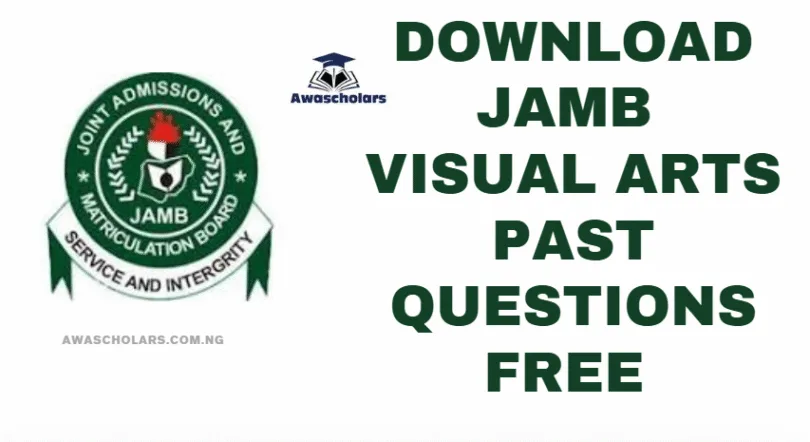Download JAMB Visual Arts Past Questions Free 2024:- Visual Arts in JAMB may seem like a creative subject, but don’t be fooled—it requires a good mix of practical knowledge, artistic theory, and critical thinking. If you want to excel, solving past questions is one of the best ways to prepare. Not only will it give you insight into the exam format, but it will also help you refine your skills and improve your understanding of key art principles. In this guide, I’ll walk you through how to download JAMB Visual Arts past questions for free, why they are essential to your success, and how to use them to prepare for the 2024 exam.
Download JAMB Visual Arts Past Questions Free 2024
Here are 20 sample multiple-choice (OBJ) JAMB Visual Art past questions for practice:
1. Which of the following is considered the primary color?
A) Orange
B) Green
C) Blue
D) Brown
2. Which of the following techniques is used in creating texture in a painting?
A) Cross-hatching
B) Smudging
C) Blending
D) Scratching
3. The process of creating three-dimensional sculptures by removing material is known as:
A) Casting
B) Modeling
C) Carving
D) Assembling
4. Which of the following is NOT a form of visual art?
A) Sculpture
B) Painting
C) Theatre
D) Photography
5. What is the main purpose of a sketch in art?
A) To create a final piece of artwork
B) To practice and experiment with shapes and designs
C) To add color to the final work
D) To serve as a decorative piece
6. Which of the following is an example of a traditional art medium?
A) Digital painting
B) Charcoal
C) Marker pens
D) Oil pastels
7. Which of the following artists is famous for their work in Cubism?
A) Leonardo da Vinci
B) Pablo Picasso
C) Michelangelo
D) Vincent van Gogh
8. What is the main difference between 2D and 3D art?
A) 2D art uses physical material, while 3D art is drawn or painted
B) 2D art is flat, while 3D art has depth and volume
C) 2D art is more expensive
D) 3D art uses more colors
9. The technique of applying paint in thin layers to create luminous effects is called:
A) Impasto
B) Glazing
C) Scumbling
D) Dry brushing
10. The process of adding pigment to a surface using a liquid medium is known as:
A) Watercolor painting
B) Printmaking
C) Pastel drawing
D) Collage
11. Which of the following is a famous work of art by Leonardo da Vinci?
A) The Last Supper
B) The Starry Night
C) The Persistence of Memory
D) The Scream
12. The term “composition” in art refers to:
A) The choice of colors used in a piece
B) The arrangement of elements in a work of art
C) The technique of applying paint
D) The historical context of the artwork
13. Which of the following is the primary function of an art gallery?
A) To provide materials for artists
B) To display works of art for public viewing
C) To educate students on the history of art
D) To sell artworks
14. The technique of creating a design by carving or cutting into a surface is known as:
A) Drawing
B) Engraving
C) Painting
D) Collage
15. The term “abstract art” refers to:
A) Art that represents real objects
B) Art that uses only geometric shapes
C) Art that does not attempt to represent reality directly
D) Art that uses lots of bright colors
16. Which of the following is the correct description of “hue” in art?
A) The brightness or dullness of a color
B) The intensity of a color
C) The name of a color
D) The texture of a color
17. What is the technique called when an artist creates an image by layering different materials, such as paper and fabric?
A) Collage
B) Sculpture
C) Drawing
D) Painting
18. The term “perspective” in visual art refers to:
A) The size and shape of the subject
B) The distance between the objects in the artwork
C) The arrangement of colors in a painting
D) The use of light in a painting
19. The process of making prints by transferring ink onto a surface using a carved design is called:
A) Lithography
B) Etching
C) Printmaking
D) Embroidery
20. Which of the following is an example of a visual art form used for architectural design?
A) Dance
B) Sculpture
C) Pottery
D) Photography
Why JAMB Visual Arts Past Questions Matter
Practicing with past questions is a game-changer for Visual Arts preparation. Here’s why:
- Familiarity with Exam Format
Visual Arts questions in JAMB cover a wide range of topics, from art history to practical skills like drawing and color theory. By practicing past questions, you’ll familiarize yourself with the question format and the different ways you can be tested, whether it’s through multiple-choice questions or essays analyzing famous artists, movements, or techniques. - Understand Key Art Concepts
Visual Arts isn’t just about drawing pretty pictures; it’s about understanding art history, techniques, and artistic movements. By going through past questions, you’ll quickly spot the recurrent topics, like famous art movements (e.g., Renaissance, Impressionism), and techniques (e.g., shading, perspective). This helps you focus on areas that are frequently tested. - Enhance Your Practical Skills
Some questions focus on visual analysis and require you to interpret images, diagrams, or paintings. Solving past questions that incorporate practical elements will help you get better at analyzing and understanding visual compositions, which is key for the art theory section and practical portions of the exam.
Where to Find Free JAMB Visual Arts Past Questions for 2024
Getting your hands on reliable and free JAMB Visual Arts past questions is crucial. Here are some trusted platforms to find them:
- JAMB Official Website
Start with the official JAMB website. They provide authentic, free past questions that are directly aligned with the current syllabus. These questions are up-to-date and reliable. - Pass.ng
Pass.ng is one of the most well-known platforms for JAMB exam preparation. They offer free past questions, including for Visual Arts, with detailed explanations for each answer. This can help you better understand the reasoning behind each question and improve your knowledge. - Examplaza.ng
Examplaza provides free downloads of past questions, including for Visual Arts. They ensure the content is up-to-date and aligned with the 2024 JAMB syllabus, giving you the most relevant resources for your preparation. - EkoBrain
EkoBrain is a solid platform for downloading past questions for all JAMB subjects, including Visual Arts. They regularly update their resources and make it easy to download the past questions you need.
How to Download JAMB Visual Arts Past Questions for Free
Here’s a simple step-by-step guide to download your JAMB Visual Arts past questions:
- Visit a Trusted Platform
Go to trusted platforms like Pass.ng, Examplaza.ng, or EkoBrain. - Select the Year (2024) and Subject (Visual Arts)
Choose the year (2024) and select Visual Arts as your subject from the available options. - Click the Download Button
Once you’ve selected the appropriate subject and year, click the download button. Some platforms may ask you to enter your email address to receive a link to the past questions. - Save and Organize
After downloading the past questions, save them in an easily accessible folder on your device. You can organize them by year or topic for easier reference. - Start Practicing
Now that you have the past questions, it’s time to start solving them. Approach each question seriously, as though you’re sitting for the actual exam.
How to Use JAMB Visual Arts Past Questions Effectively
Simply downloading the past questions isn’t enough—you need to use them strategically to maximize your preparation. Here’s how to make the most of them:
- Simulate Real Exam Conditions
Visual Arts requires a mix of theory and practical application. Time yourself while solving the questions to simulate the pressure of the real exam. This helps you manage your time effectively during the exam, especially since Visual Arts may require you to interpret images or write essays about art history and theory. - Focus on Recurrent Topics
By practicing with past questions, you’ll notice which topics appear more frequently in the exam. Focus on mastering these high-yield topics like art movements, techniques, famous artists, and art history. - Practice Your Drawing and Analysis
Some Visual Arts questions may require you to draw or interpret visual content. Practice sketching different types of artwork, paying attention to techniques like shading, perspective, and composition. Also, practice interpreting artwork and visual elements—analyze how color, texture, and space contribute to the meaning of the art. - Understand the Questions Thoroughly
Take time to read and understand each question carefully. Some may test your knowledge of art movements, while others may require a deep understanding of the technical aspects of visual composition. Don’t rush through your answers; instead, focus on analyzing each question and breaking it down. - Review Mistakes
If you get a question wrong, don’t just move on. Review your mistakes and identify what you missed. Understanding why a certain answer is correct will help you reinforce your learning and avoid making the same mistakes in the future.
ALSO READ
- Download JAMB Chemistry Past Questions Free 2024
- Download JAMB Physics Past Questions Free 2024
- Download JAMB Biology Past Questions Free 2024
- Download JAMB Yoruba Past Questions Free 2024
- Download JAMB Mathematic Past Questions Free 2024
- Download JAMB English Past Questions Free 2024
- Download JAMB Further Maths Past Questions Free 2024
- Download JAMB Government Past Questions Free 2024
- Download JAMB Economics Past Questions Free 2024
- Download JAMB Lit. In English Past Questions Free 2024
- Download JAMB Music Past Questions Free 2024
- How Much Is EKSU Acceptance Fee for 2025/2026 ?
Additional Tips to Ace JAMB Visual Arts in 2024
Here are a few extra strategies to help you succeed in Visual Arts:
- Master the Art Movements and Artists
JAMB often tests your knowledge of major art movements (such as Impressionism, Cubism, and Renaissance) and famous artists (like Leonardo da Vinci, Pablo Picasso, and Vincent van Gogh). Review key artists, their works, and the historical context of each movement. - Know Your Artistic Terminology
Visual Arts uses specific terminology that you’ll need to understand and apply. Familiarize yourself with terms like composition, contrast, balance, harmony, and texture. These are frequently tested in both theory and practical questions. - Develop Your Visual Analysis Skills
Art interpretation is crucial in Visual Arts. Practice analyzing artworks, understanding how light, color, and texture influence the message of the art. The more you practice, the better your analysis will become. - Use Online Resources
There are several online platforms, YouTube channels, and resources that offer free lessons on art theory, drawing techniques, and art history. Use these to supplement your past question practice. - Study with Peers
Form a study group to discuss different artists, movements, and techniques. Group study can help clarify difficult concepts, and you can quiz each other on famous works of art, techniques, and key terms.
Maximizing Your Free JAMB Past Questions Download
Once you’ve downloaded your past questions, here’s how to make the most out of your practice:
- Combine Free with Paid Resources
While free past questions are excellent, investing in premium study guides or art-related study apps can provide additional insights and deeper explanations that will improve your understanding of the subject. - Track Your Progress
Use Google Sheets or Trello to monitor which past questions you’ve solved and which topics you’ve covered. Tracking your progress will ensure you’re revising systematically and not overlooking any key areas. - Use Art Apps
Download apps like JAMB Exam Prep 2024 to practice Visual Arts questions on the go. Many apps include mock exams and additional practice questions that help you track your performance.
Conclusion
JAMB Visual Arts may seem like a creative subject, but it requires a solid foundation of theory, history, and technique. By downloading and practicing with JAMB Visual Arts past questions, you’ll not only get familiar with the exam format but also deepen your understanding of key concepts like art history, techniques, and artistic analysis. Stay consistent, focus on the areas that matter most, and use your mistakes as opportunities to improve. With dedication and smart practice, you’ll be fully prepared for the 2024 exam. Best of luck in your studies!






